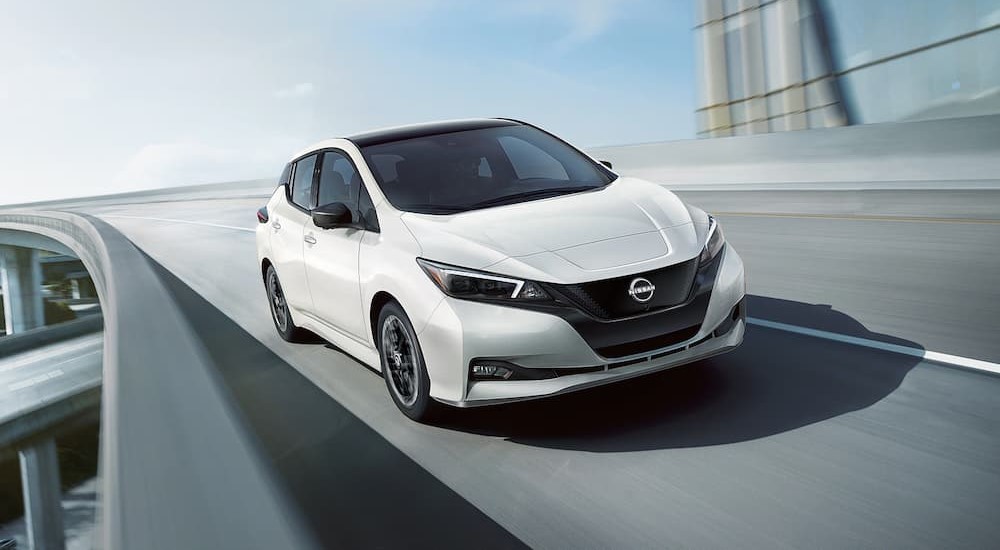Routine maintenance is one of the many considerations when shopping for electric vehicles for sale. Every car, whether it has an internal combustion engine or an electric powertrain, is an investment worth protecting, and scheduled maintenance is essential to extending its longevity and heightening its performance. But what does that maintenance look like for electric vehicles?
The Nissan LEAF is one of the most popular and longest-running electric vehicles, with the groundbreaking model setting new standards in the industry with its affordability and value-oriented packaging. Moreover, the LEAF proves that electric vehicles don’t compromise performance and offer an incredible return on your investment. With an electric car like the LEAF, scheduled maintenance is minimal, keeping more money in your wallet and adding to the already incredible savings you can enjoy from not having to fill the car with gas.
Why EV Maintenance Is Easier
Electric vehicles can seem intimidating because they’re new, and we’re used to gasoline cars with internal combustion engines. However, electric powertrains are far simpler than their gas-powered siblings. As a result, maintenance is more straightforward, adding to the appeal of an EV like the Nissan LEAF.
The LEAF doesn’t require routine oil changes because the electric motor doesn’t rely on oil to cool, clean, or lubricate its components. In addition, there are no spark plugs to change, and there are minimal fluids to worry about checking, topping off, or replacing. So, what type of maintenance does the LEAF require?

LEAF Scheduled Maintenance: The Basics
Getting the most from your Nissan LEAF comes down to knowing how it operates and having a scheduled maintenance plan. As a LEAF owner, you’re responsible for its condition, from a small dent in the fender or a cracked windshield to tires with low pressure or inoperable lights. Being mindful of your LEAF’s condition is a daily endeavour, whether noticing a headlight that doesn’t work, a warning light on the dashboard, a soft or spongy brake pedal, or an air conditioner that doesn’t properly cool.
This awareness is considered general maintenance, with the LEAF’s routine maintenance requiring more in-depth assessments by EV-certified technicians. Nissan outlines the optimal schedule in your owner’s manual, with the intervals falling every six months or 12,000 km, depending on driving conditions. We’re here to simplify that maintenance even further, breaking your LEAF’s scheduled maintenance needs into categories.
Battery
The LEAF relies on two batteries: a lithium-ion propulsion battery and a 12-volt lead-acid starter battery like those found in a gas-powered vehicle. The 12-volt battery delivers the power necessary to operate the headlights, radio, windshield wipers, and other essential components, while the lithium-ion battery has a much bigger job. It’s dedicated to powering the LEAF’s electric motor and recharging the 12-volt battery as you drive.
The LEAF’s battery system is undoubtedly its most essential component, so it’s easy to see why the batteries should be tested and inspected regularly. Every six months or 12,000 km, EV-certified technicians will assess the 12-volt battery, checking the terminals and cables. Then, every 12 months or 24,000 km, the technicians will run an EV battery usage report on the lithium-ion battery. This report is required under Nissan’s warranty coverage and provides vital insights into your LEAF’s propulsion battery, which the technician will explain and review with you during the 12-month appointments.
Tires
The tires on your LEAF are its only point of contact with the road, making them essential to your safety behind the wheel. Tire maintenance is straightforward, with Nissan encouraging LEAF owners to know how to use the tire pressure monitoring system and look for signs of excessive tire wear. The tires should be rotated and inspected every six months or 12,000 km, with the technicians assessing the condition and depth of the tread and noting other signs of wear or potential issues. Once the tires wear down to the tread wear indicator bars, it’s time to replace them with a new set.
Brakes
Electric vehicles like the LEAF are renowned for introducing a more efficient braking system known as regenerative braking. Traditional brakes waste significant energy, which the regenerative braking system captures and converts to electricity the LEAF’s battery can use to extend its driving range. In addition, regenerative brakes extend the lifespan of the LEAF’s standard brakes, actively reducing wear and tear.
The routine service appointments scheduled every six months or 12,000 km include a standard brake inspection. During this inspection, technicians will look at the brake pads and rotors, checking for wear and leaks. The brakes are more thoroughly inspected every 12 months or 24,000 km, with technicians examining the brake lines and cables for leaks, damage, or deterioration. While pad and rotor replacement intervals will depend on your driving style, Nissan recommends replacing the brake fluid every 24 months or 48,000 km.

Steering and Suspension
While you may not spend a lot of time thinking about the LEAF’s suspension or steering components, they’re critical to the EV’s longevity and performance. Every routine service appointment includes a multi-point inspection where technicians evaluate the suspension components, like the shocks and tie rods. Then, every 24 months or 48,000 km, they’ll assess the front ball joints and perform a comprehensive inspection of the steering gear, linkages, and drive shaft boots, replacing damaged or worn components as necessary.
Charging Components
The LEAF’s battery and charging components are integral to its operation as an electric vehicle. Routine battery inspections ensure the LEAF’s 12-volt and lithium-ion batteries are in excellent working condition, but where does that leave the charging components? Nissan recommends having the LEAF’s charging port inspected every 12 months or 24,000 km, whichever occurs first. Then, every 24 months, or 48,000 km, the sealing cap should be checked by an EV-certified technician.
Fluids and Cabin Air Filter
The last major maintenance components for the LEAF include checking its fluids and replacing the cabin air filter. Nissan recommends replacing the LEAF’s cabin air filter every 12 months or every 24,000 km. If you spend more time driving in dusty or debris-laden environments, you’ll need to replace the LEAF’s cabin air filter more frequently.
Along with replacing the cabin air filter each year, you’ll also want to be mindful of the LEAF’s fluid levels. While electric vehicles don’t rely on oil or as many fluids as cars, trucks, or SUVs with internal combustion engines, models like the LEAF still need coolant and brake fluid to operate correctly. Routine service appointments include fluid level checks, where the technician will assess the level and quality of the brake fluid and look for other leaks. This inspection includes checking the coolant level, which Nissan recommends replacing at 200,000 km or 15 years.
Maintenance Made Easy
The Nissan LEAF is one of the most popular electric vehicles on the road, and it’s easy to see why once you get behind the wheel. It’s engaging and fun to drive, with a surprising penchant for speed heightened by its responsiveness and smaller footprint. Nissan adds to the LEAF’s appeal with its affordable price tag that doesn’t require drivers to settle for less, and the perks don’t stop there.
Owning a LEAF is just as rewarding and budget-savvy because you aren’t spending a fortune on routine maintenance. Instead, the LEAF’s electric powertrain is straightforward, eliminating the need for oil and filter changes and keeping more money in your wallet. The LEAF’s scheduled maintenance comes down to being mindful of its main components: tires, brakes, steering, and suspension. Then, with a trusted EV-certified technician capable of handling the details, you can spend the rest of your time enjoying the tangible value and thrills of owning a best-selling EV like the LEAF.

